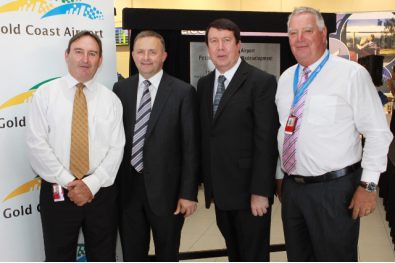Nestled among 52 kilometres of pristine surfing beaches, Gold Coast Airport has become a key gateway for tourism traffic and low-fare carriers arriving from both domestic and international destinations.
Almost three decades ago, Gold Coast Airport (OOL) welcomed around 300,000 passengers. Last year, during construction of its AUD$100 million (US$89 million) passenger terminal, Australia’s first purpose built facility for low-cost carriers (LCCs), that figure was close to five million passengers a year.
Dennis Chant, managing director of Queensland Airports Limited explains the gateway’s transformation: “The terminal has undergone several upgrades since 1981 but our growth over recent years necessitated the need for this significant expansion.”
Gold Coast Airport has positioned itself as an attractive base for LCCs, that are able to take advantage of the new terminal’s ability to operate quick aircraft turnarounds and fast passenger processing (60 minutes or less for international flights). The new T2 facility provides common use facilities for domestic and international traffic under one roof.
A partnership with Queensland Government has been an important factor in securing new route incentives, which can support new international air services to Queensland. In turn, the airport offers some of the lowest passenger charges to airline, under-cutting large Australian hubs, including its neighbour, Brisbane airport.
Route Network
The airport’s first long-haul international carrier was AirAsia X, which started operating flights from Kuala Lumpur in November 2007. This service is now daily.
Tiger Airways is also well established at the airport, having arrived in 2007 and in December it launched flights to the Gold Coast from Sydney. The carrier has just doubled capacity this month on the routing.
Gold Coast’s international routes include a daily service to Osaka and Tokyo, as well as six-times weekly flights to Malaysia and 20 weekly frequencies to New Zealand. The domestic schedule is also growing, including up to 23 daily flights to Sydney that are currently offered.
Airport Approach
In January, Gold Coast Airport achieved a monthly record of 464,056 passenger movements, representing a 23% rise in international traffic.
A runway extension in 2007 has been key to ensuring that Gold Coast Airport can serve nearly all wide-body aircraft (besides the A380) on long-haul routes.
“Markets that we are targeting this year include China, South East Asia, India and the Middle East,” says Chant.
As well as being an attractive point of entry for inbound tourists, the airport is working collaboratively to promote the airport’s outbound growth potential.
“Our marketing department use co-operative funds to help build load factors for our partner airlines. This fund drives outbound traffic and is maximised with buy-in from Gold Coast Tourism and Tourism QLD – our state promotion organisation,” says Chant.
Gold Coast Airport welcomes enquiries from airlines and aviation operators and offers incentives for charter or scheduled carriers, through terminal charge incentives, business development support, and in-kind and cash marketing support.
Please visit the Gold Coast marketing profile for further details.
|
Officially opening Gold Coast Airport’s new LCC terminal: (from left) Dennis Chant, managing director of QLD Airports Limited (owners of Gold Coast Airport); Anthony Albanese, federal minister for Infrastructure; Paul Lucas, Queensland deputy minister and Paul Donovan, COO of Gold Coast Airport. |






